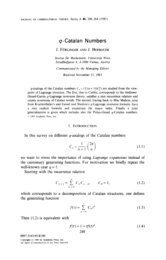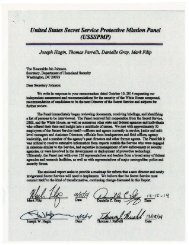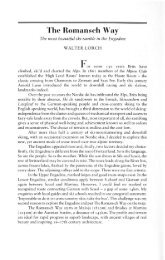010815as1
You also want an ePaper? Increase the reach of your titles
YUMPU automatically turns print PDFs into web optimized ePapers that Google loves.
inflation for the years between 1986 and 1999. 513 As a result, the indicator has only risen 37<br />
percent, from $1.00 to $1.37, since 1986. Meanwhile, inflation over that period would have<br />
increased the indicator from $1 of damage to $2.15 in 2014. 514<br />
GAO analyzed actual and projected obligations for 508 disaster declarations which<br />
received Public Assistance grants during fiscal years 2004-2011. 515 It found that fewer disasters<br />
would have been declared had FEMA updated the indicator to consider increases in personal<br />
income or price inflation for all of the years since 1986. Specifically, GAO found that nearly<br />
half—a full 44 percent—of those disasters would not have met the threshold indicator if the<br />
indicator had been adjusted for changes in income, and that 25 percent would have failed to<br />
qualify had the per capita damage indicator been adjusted for inflation. 516<br />
The use of the per capita damage indicator also creates a bias in favor of declaring<br />
disaster in small-population states. Because the indicator is determined by dividing the dollar<br />
amount of damage by the state’s population, a state with a low population can meet FEMA’s<br />
threshold of $1.37 with a lower amount of damage than a state with a larger population. For<br />
example, in 2013, a major winter storm hit a broad part of the northern Texas and southern<br />
Oklahoma. Both states applied for disaster relief. The estimated amount of damage in Oklahoma<br />
was $6.4 million, which amounted to a statewide damage indicator of $1.70, which met FEMA’s<br />
per capita damage threshold, and led to a declaration covering a number of counties that border<br />
Texas. 517 The preliminary damage assessment for the same winter storm in Texas was $30<br />
million, 518 which fell $5 million short of the number needed to get Texas above the per capita<br />
damage indicator. As a result, FEMA denied Texas’s request for a major disaster declaration in<br />
513 U.S. Government Accountability Office, “Improved Criteria Needed to Assess Jurisdictions Capability to<br />
Respond and Recover on Its Own,” GAO-12-838, September, 2012, pg. 24,<br />
http://www.gao.gov/assets/650/648162.pdf<br />
514 “CPI Inflation Calculator,” http://data.bls.gov/cgi-bin/cpicalc.pl, accessed May 23, 2014.<br />
515 U.S. Government Accountability Office, “Improved Criteria Needed to Assess Jurisdictions Capability to<br />
Respond and Recover on Its Own,” GAO-12-838, September, 2012, , pg. 24;<br />
http://www.gao.gov/assets/650/648162.pdf,.<br />
516 U.S. Government Accountability Office “Improved Criteria Needed to Assess Jurisdictions Capability to<br />
Respond and Recover on Its Own,”, GAO-12-838, September, 2012, , p. 24;<br />
http://www.gao.gov/assets/650/648162.pdf,.<br />
517 “Oklahoma – Sever Winter Storm,” FEMA.gov, January 30, 2014; pg. 2, http://www.fema.gov/media-librarydata/1393619267269-e777eab6d237c9da9fce6405e2c9107a/PDA+Report+FEMA-4164-DR-OK.pdf,<br />
.<br />
518 “Texas Severe Winter Storm – Denial of Appeal,” FEMA, April 15, 2014; http://www.fema.gov/medialibrary/assets/documents/95015,.<br />
111








![55721335-d6fe09eb5ffdcc87dbf6c3f0b5bbda07d2261e98[1]](https://img.yumpu.com/56533583/1/186x260/55721335-d6fe09eb5ffdcc87dbf6c3f0b5bbda07d2261e981.jpg?quality=85)








